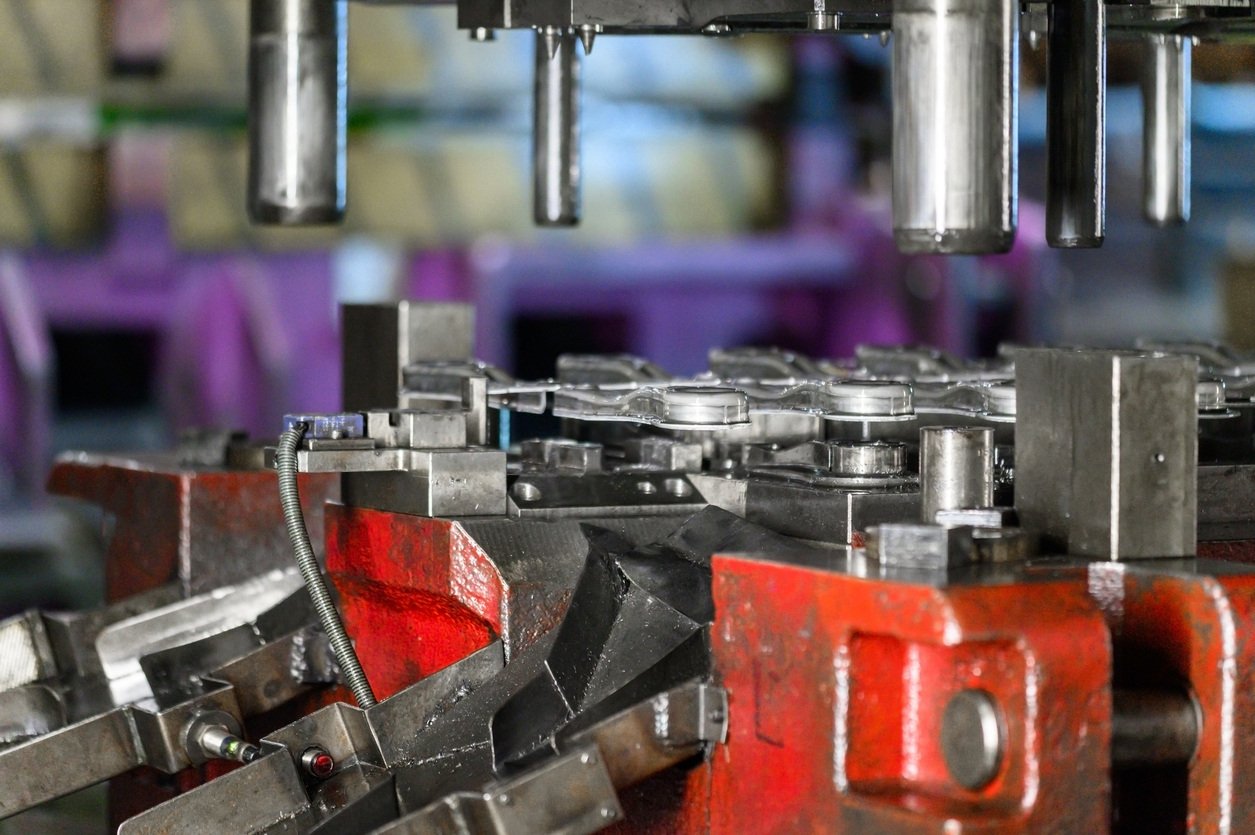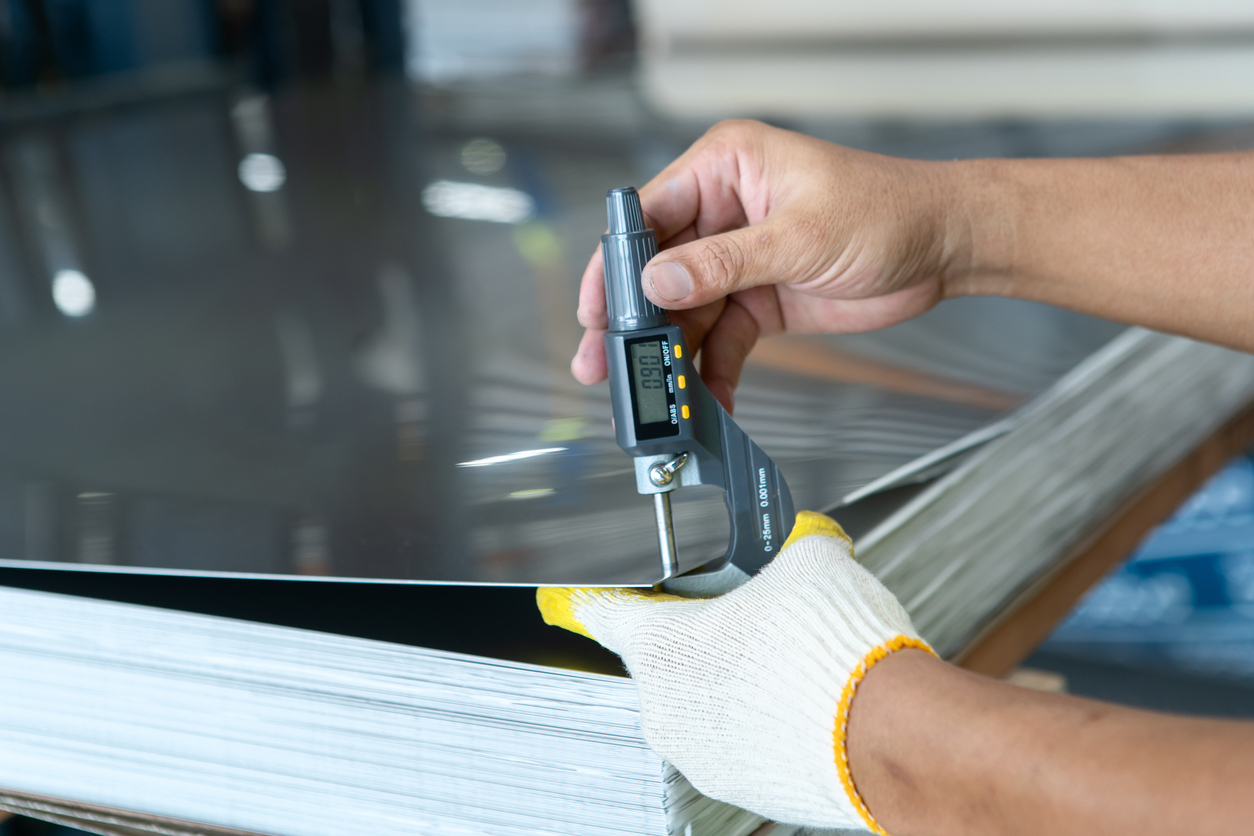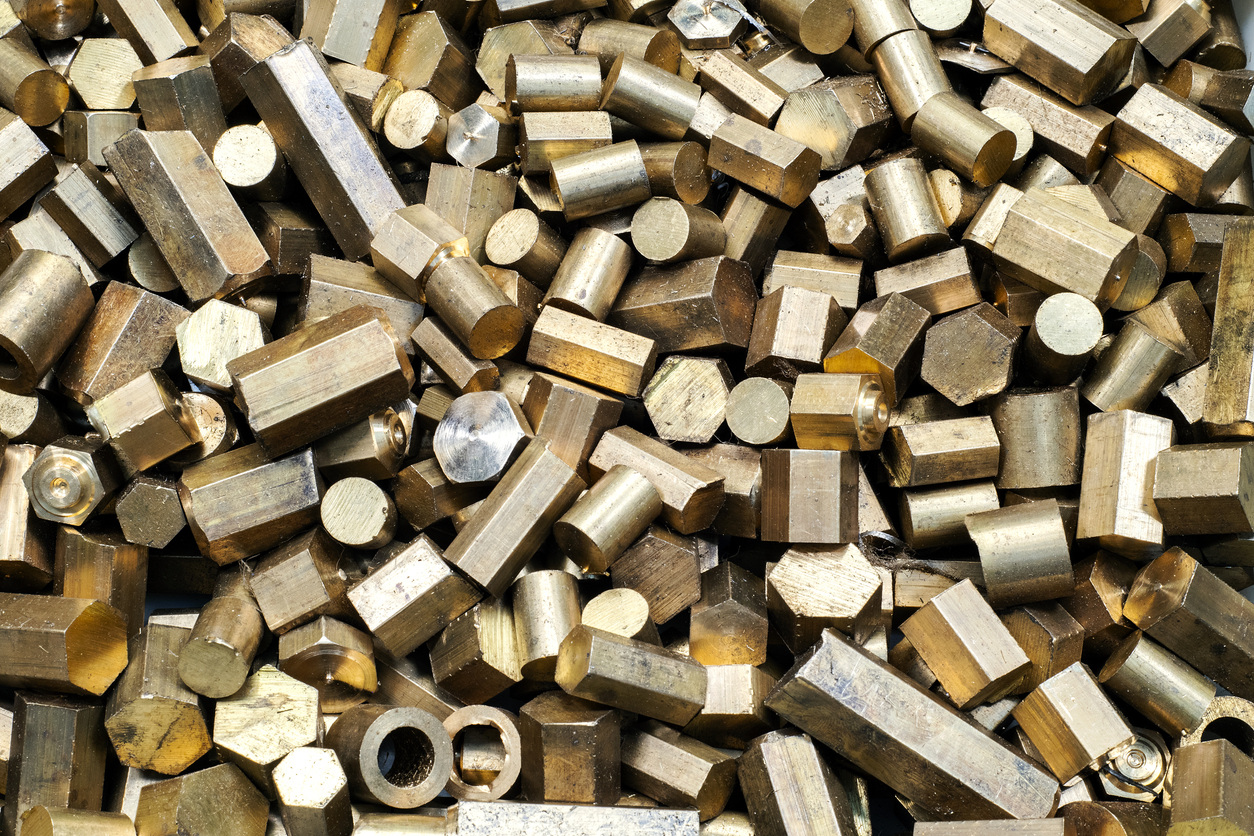What Are EDM Machining Tolerances for Sheet Metal Stamping?

Do EDM Machining Tolerances Offer Precise Tooling for Metal Stamping?
When you think about high-precision manufacturing, what comes to mind? For many engineers, it's the ability to repeatedly produce components that meet the exacting specifications of EDM (electrical discharge machining) tolerances of 0.001” or tighter on critical features.
This level of accuracy doesn't happen by accident. It's the result of sophisticated tooling technologies, with EDM machining tolerances leading the charge in creating the precision dies that make demanding specs possible.
EDM represents a shift in how we approach tooling for sheet metal stamping operations. While conventional machining methods have their place, EDM opens doors to geometries and precision levels that were once considered impossible. For engineers working in aerospace, medical devices, or any application where part precision directly impacts safety and performance, understanding EDM machining tolerances isn't just beneficial — it's what can make the difference between success and failure.
EDM Tolerances by Process
The versatility of EDM technology manifests in several distinct processes, each optimized for specific applications and shape requirements. Understanding the capabilities and tolerances of each process enables engineers to select the best approach for their tooling needs.
|
EDM Process |
Best For |
Tolerances |
Key Capabilities |
|
Wire EDM |
Intricate profiles, sharp internal corners, fine features |
±0.0001" to ±0.0003"; radii as small as 0.0005" |
Creates punch/insert geometry in progressive dies, cuts hardened materials without thermal stress |
|
Sinker EDM |
Complex 3D cavities, mold features, form punches |
±0.0002" to ±0.0005" |
Handles deep cavities, undercuts, and intricate internal geometries; reduces tooling complexity and improves accuracy |
|
Hole EDM |
Micro-holes and starter holes |
±0.0001"; holes as small as 0.008" |
Ideal for cooling channels, precise hole patterns, and starter holes for wire EDM |
By combining wire, sinker, and hole EDM, toolmakers achieve high-precision dies and reliable production of stamped parts.
What Do EDM Tolerances Have to Offer?
The foundation of any successful stamping operation lies in the precision of its tooling. When dies are manufactured to exacting standards, they enable consistent part production that meets specifications across thousands, or even millions, of cycles.
EDM’s tolerances are as good as it gets in the fabrication industry. Why’s this matter to you? Because it directly influences three critical aspects of your manufacturing success:
1. Consistency That Scales With Production
Progressive dies built with EDM-level precision demonstrate remarkable stability across extended production runs. The dimensional accuracy achieved through EDM processes translates to:
- Lower part-to-part variation
- Reduced scrap rates
- Improved statistical process control (Cpk) values
This consistency becomes increasingly important as production volumes scale, where even small percentage improvements in yield can result in significant cost savings.
2. Unlocking Complex Geometries
Sharp internal corners, intricate profiles, and micro-features can be precisely formed in tool steel, allowing stamping operations to produce parts with sophisticated designs. This capability is valuable in industries where miniaturization and complexity go hand-in-hand, such as electronics and medical device manufacturing.
Minimizing Adjustments for Faster, More Reliable Output
Finally, the precision achievable with EDM processes reduces the need for secondary operations and adjustments during production. Dies that are manufactured to tight tolerances from the outset require fewer in-process modifications, leading to reduced setup times and more predictable production schedules. This reliability is especially crucial in reducing manufacturing lead time for quick-turn projects.
Right-Sizing Stamping Tolerances
Understanding when to specify tight tolerances and when not to represents a critical engineering decision that impacts both cost and functionality.
In the context of stamping operations, "tight-tolerance" typically refers to dimensional requirements of 0.001” or tighter on critical features. While EDM tooling can achieve even greater precision, the key lies in applying this capability strategically.
The importance of appropriate tolerancing extends beyond mere dimensional accuracy. In safety-critical applications, precise part geometry ensures proper fit and function in assemblies where failure is not an option. Medical implants, aerospace components, and automotive safety systems all depend on parts that meet exacting standards not just initially, but throughout their service life.
However, tooling precision drives part precision in a direct relationship — small die errors multiply across production volumes. A die feature that's off by 0.0005” will produce thousands of parts with that same error, potentially leading to assembly issues, functional problems, or outright rejection. The cost of precision tooling must be weighed against the potential production issues it may cause and the value of the parts being produced.
The cost-precision trade-off requires careful consideration. Not every feature on every part needs ultra-tight tolerances. Strategic tolerance assignment involves identifying critical dimensions that affect part function and applying tight specs only where necessary. Features that don't impact assembly, function, or safety can often accommodate more relaxed tolerances, reducing both tooling costs and production complexity.
Effective Design for Manufacturability (DFM) collaboration becomes key in this process. Engaging tooling experts early in the design phase helps avoid "gold-plating" tolerances that inflate both cost and lead time without providing functional benefits. Early collaboration also enables the identification of features that may be difficult or expensive to achieve with conventional tooling but are readily accomplished with EDM processes.
What Drives Achievable Tolerances in Production?
Several factors influence the tolerances achieved in actual production, even though EDM tooling provides the foundation for high-precision stamping. Understanding these variables allows engineers to design both tooling and processes that work together to achieve quality consistently.
Material Factors
- Hardness: This affects how cleanly the material shears during stamping; tougher materials may cause die wear or burr formation.
- Abrasiveness: This factor influences tool life and can cause gradual changes in die dimensions over extended production runs.
- Ductility and formability: Determine how the material responds to bending and forming, which directly impacts the precision of the formed features.
- Tensile strength: Affects the amount of force required for cutting and forming operations.
- Grain direction: This can create directional variations in material properties, influencing dimensional consistency.
Process Parameters
- Press speed: Higher speeds can cause variations in part dimensions due to material flow characteristics, affecting the dynamics of the stamping operation.
- Forming forces: Careful control is a must to ensure consistent material deformation without tool deflection or workpiece distortion.
- Lubrication: A crucial factor in reducing friction and ensuring smooth material flow through the die.
- Temperature and humidity: These conditions can significantly influence material properties and dimensional stability, especially in applications where thermal expansion becomes critical.
Design and Validation Processes
- Up-front modeling and simulation: Help predict material behavior and optimize die geometry for consistent results.
- Advanced engineering capabilities: Including 3D modeling and finite element analysis, these tools enable the identification of potential issues before physical prototyping.
- Quality assurance measures: Coordinate measuring machines, laser scanning, and comprehensive inspection protocols verify that both tooling and parts meet specs throughout production.
The integration of these factors requires careful attention to detail and comprehensive process control. ISO 9001:2015 quality systems provide the framework for consistency and continual improvement, ensuring that all variables affecting part quality are properly controlled and monitored, start to finish.
The Benefits of EDM-Level Accuracy for Stamping Programs
The investment in EDM-manufactured tooling delivers tangible benefits that extend well beyond the initial precision. These benefits compound over the life of the tooling, creating significant value for manufacturing programs that demand consistency and reliability.
Consistency at Volume
Precision tooling manufactured with EDM processes demonstrates remarkable stability across extended production runs. The dimensional accuracy built into the dies translates directly to reduced part-to-part variation, helping manufacturers to achieve stable Cpk values across thousands or millions of stamping cycles.
This consistency reduces the need for process adjustments during production, minimizes scrap generation, and enables more predictable quality outcomes.
The stability provided by EDM tooling becomes increasingly valuable as production volumes increase. Minor improvements in process capability can result in substantial cost savings when multiplied across high-volume production runs.
Also, the reduced variability allows tighter control of downstream processes, as parts entering assembly or secondary operations exhibit more consistent dimensional characteristics.
Complexity Without Compromise
EDM processes enable the creation of custom, intricate die geometries that would be difficult or impossible to achieve with conventional machining methods. Sharp internal corners, complex profiles, and micro-features can be precisely formed in tool steel, enabling the production of parts with sophisticated geometries while maintaining tight tolerances.
This capability is valuable in applications where part complexity is driven by functional requirements rather than manufacturing convenience. Electronic components, medical devices, and aerospace parts often require features that push the boundaries of conventional manufacturing, making EDM tooling essential for their successful production.
Lower Risk in Regulated Industries
Aerospace, medical device, and electronics manufacturing operate under stringent regulatory requirements where part accuracy and repeatability directly impact safety and compliance. EDM-manufactured tooling provides the precision and consistency required to meet these demanding standards, reducing the risk of field failures and regulatory issues.
The documentation and traceability requirements common in regulated industries align well with the manufacturing capabilities of EDM processes. The ability to demonstrate that tooling meets specification and that parts are produced consistently within tolerance provides all the evidence you need for regulatory compliance and quality audits.
Life Cycle Economics
While EDM tooling may require a higher initial investment compared to conventional manufacturing methods, the long-term economics often favor the precision approach. Higher up-front precision reduces tool wear rates, minimizes the need for emergency repairs or rebuilds, and reduces production downtime caused by tooling issues.
The extended tool life achievable with properly designed EDM tooling can be viewed as a form of cost avoidance. This economic advantage becomes more pronounced in high-volume applications where tooling costs are amortized across many parts.|
EDM vs. Other Machining Methods
The decision between EDM and other machining methods depends on the specific requirements of the tooling application. Each process has distinct advantages that make it suitable for particular types of work, and the most effective toolmaking operations often combine multiple methods to achieve optimal results.
CNC milling and turning offer speed and versatility that make them ideal for many die components. These conventional processes excel at creating basic shapes, removing large amounts of material quickly, and achieving good surface finishes on external features. CNC machining is typically more cost-effective for simple geometries and can be highly automated for repetitive operations.
However, CNC processes are limited by tool access and the mechanical properties of cutting tools. Complex internal geometries, sharp corners, and very small features may be difficult or impossible to achieve with conventional cutting tools. This is where EDM becomes invaluable, handling the profiles, corners, and micro-features that cutters cannot cleanly create, while conventional machining efficiently produces the bulk of the die structure.
Precision grinding provides exceptional flatness and surface finish quality, making it important for die surfaces that require precise dimensional control or optimal surface characteristics. Grinding excels at achieving tight tolerances on flat and cylindrical surfaces while providing the surface finish quality required for optimal part quality.
EDM complements grinding by handling complex internal geometries that cannot be reached with grinding wheels. The combination of EDM for internal features and grinding for external surfaces often provides the optimal balance of precision, surface quality, and efficiency in toolmaking operations.
Electrochemical machining (ECM) offers burr-free finishing and can produce mirror-quality surfaces on select geometries. The process is valuable for applications where surface finish directly impacts part quality or where burr removal would be difficult or impossible after machining.
EDM and ECM can work together in advanced toolmaking applications, with EDM creating the basic geometry and ECM providing specialized surface treatments or finishing operations. This combination allows for the production of tooling with both geometric precision and optimal surface characteristics for demanding applications.
The most effective approach often involves combining multiple processes to leverage the strengths of each while minimizing their individual limitations. Small metal parts manufacturing often benefits from a multi-process approach, where different manufacturing methods are strategically applied to achieve the required precision, surface quality, and shape complexity.
High-Precision Tooling: The Foundation of Manufacturing Excellence
The exceptional accuracy achievable with EDM enables manufacturers to produce complex parts with consistently tight tolerances, meeting the demanding requirements of the aerospace, medical, and electronics industries.
Understanding when and where to apply its unique capabilities represents a significant competitive advantage in high-precision manufacturing. By combining EDM with complementary processes like conventional machining and precision grinding, manufacturers can balance precision, efficiency, and cost-effectiveness.
Find Your EDM Solution with JV Manufacturing
Whether you require high-volume production tooling or prototypes for cutting-edge components, JV Manufacturing possesses the expertise and capabilities to meet the most demanding requirements consistently with cost-effectiveness.
Ready to take your manufacturing to the next level? Let JV Manufacturing provide the EDM solutions you need. Our team is here to guide you through the process and ensure your project goals are met with precision and reliability. Contact us today to learn more and get started!
You May Also Like
These Related Stories

Metal Stamping Applications for 3 Key Industries

Understanding Stamping Thickness for Metal Stamping Success

%201.png?width=146&height=103&name=Slice%203%20(72)%201.png)


